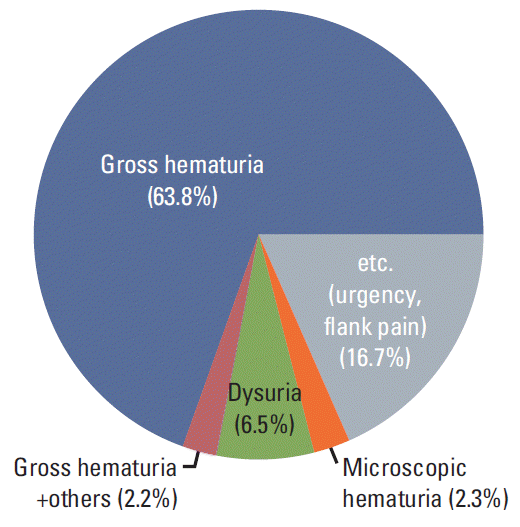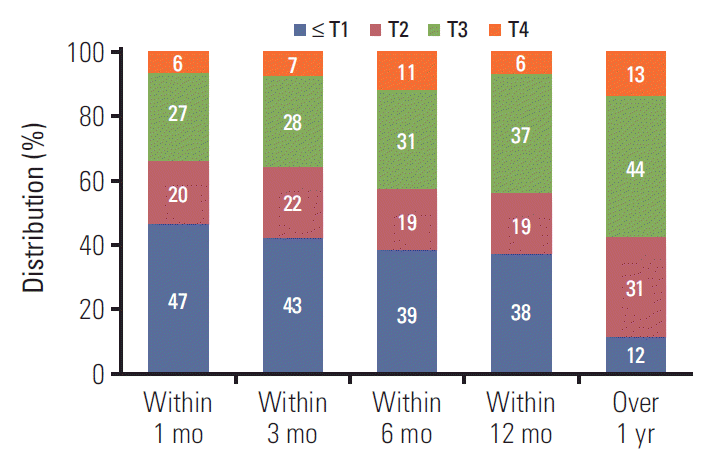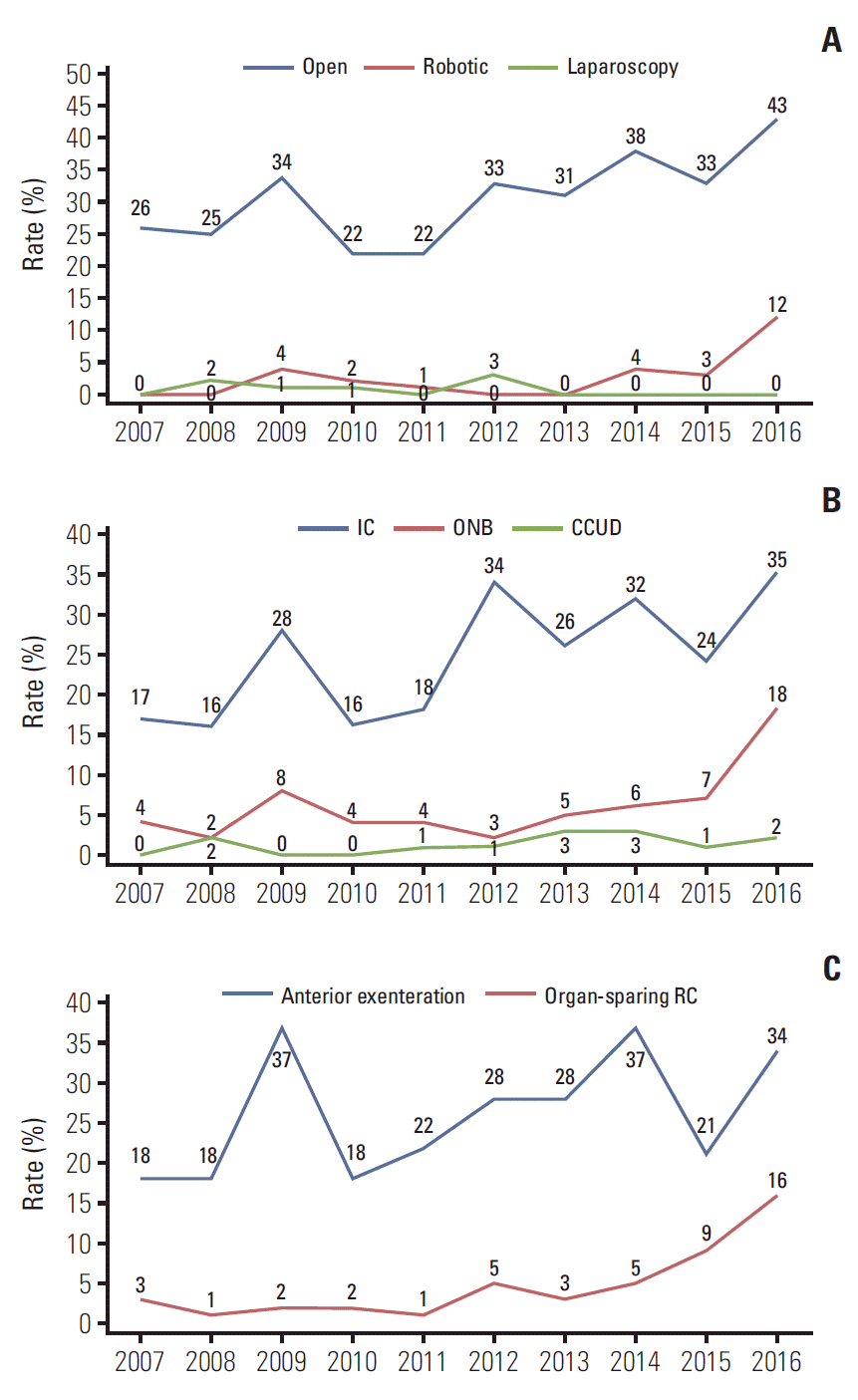1. Cheng L, Weaver AL, Leibovich BC, Ramnani DM, Neumann RM, Scherer BG, et al. Predicting the survival of bladder carcinoma patients treated with radical cystectomy. Cancer. 2000; 88:2326–32.

2. Messer JC, Shariat SF, Dinney CP, Novara G, Fradet Y, Kassouf W, et al. Female gender is associated with a worse survival after radical cystectomy for urothelial carcinoma of the bladder: a competing risk analysis. Urology. 2014; 83:863–7.

3. Fajkovic H, Halpern JA, Cha EK, Bahadori A, Chromecki TF, Karakiewicz PI, et al. Impact of gender on bladder cancer incidence, staging, and prognosis. World J Urol. 2011; 29:457–63.

4. Herkommer K, Hofer C, Gschwend JE, Kron M, Treiber U. Gender and body mass index as risk factors for bladder perforation during primary transurethral resection of bladder tumors. J Urol. 2012; 187:1566–70.

5. Kluth LA, Fajkovic H, Xylinas E, Crivelli JJ, Passoni N, Roupret M, et al. Female gender is associated with higher risk of disease recurrence in patients with primary T1 high-grade urothelial carcinoma of the bladder. World J Urol. 2013; 31:1029–36.

6. van der Poel HG, Boon ME, van der Meulen EA, Wijsman-Grootendorst A. The reproducibility of cytomorphometrical grading of bladder tumours. Virchows Arch A Pathol Anat Histopathol. 1990; 416:521–5.
7. Johnson EK, Daignault S, Zhang Y, Lee CT. Patterns of hematuria referral to urologists: does a gender disparity exist? Urology. 2008; 72:498–502.

8. Bhatta Dhar N, Kessler TM, Mills RD, Burkhard F, Studer UE. Nerve-sparing radical cystectomy and orthotopic bladder replacement in female patients. Eur Urol. 2007; 52:1006–14.

9. Ali-El-Dein B, Mosbah A, Osman Y, El-Tabey N, Abdel-Latif M, Eraky I, et al. Preservation of the internal genital organs during radical cystectomy in selected women with bladder cancer: a report on 15 cases with long term follow-up. Eur J Surg Oncol. 2013; 39:358–64.

10. Gakis G, Efstathiou J, Lerner SP, Cookson MS, Keegan KA, Guru KA, et al. ICUD-EAU International Consultation on Bladder Cancer 2012: Radical cystectomy and bladder preservation for muscle-invasive urothelial carcinoma of the bladder. Eur Urol. 2013; 63:45–57.

11. Stein JP, Lieskovsky G, Cote R, Groshen S, Feng AC, Boyd S, et al. Radical cystectomy in the treatment of invasive bladder cancer: long-term results in 1,054 patients. J Clin Oncol. 2001; 19:666–75.

12. Madersbacher S, Hochreiter W, Burkhard F, Thalmann GN, Danuser H, Markwalder R, et al. Radical cystectomy for bladder cancer today: a homogeneous series without neoadjuvant therapy. J Clin Oncol. 2003; 21:690–6.
13. Hautmann RE, Gschwend JE, de Petriconi RC, Kron M, Volkmer BG. Cystectomy for transitional cell carcinoma of the bladder: results of a surgery only series in the neobladder era. J Urol. 2006; 176:486–92.

14. Herr HW, Faulkner JR, Grossman HB, Natale RB, deVere White R, Sarosdy MF, et al. Surgical factors influence bladder cancer outcomes: a cooperative group report. J Clin Oncol. 2004; 22:2781–9.

15. Nguyen DP, Al Hussein Al Awamlh B, Wu X, O'Malley P, Inoyatov IM, Ayangbesan A, et al. Recurrence patterns after open and robot-assisted radical cystectomy for bladder cancer. Eur Urol. 2015; 68:399–405.

16. Mungan NA, Aben KK, Schoenberg MP, Visser O, Coebergh JW, Witjes JA, et al. Gender differences in stage-adjusted bladder cancer survival. Urology. 2000; 55:876–80.

17. Granberg CF, Boorjian SA, Crispen PL, Tollefson MK, Farmer SA, Frank I, et al. Functional and oncological outcomes after orthotopic neobladder reconstruction in women. BJU Int. 2008; 102:1551–5.

18. Ali-El-Dein B. Oncological outcome after radical cystectomy and orthotopic bladder substitution in women. Eur J Surg Oncol. 2009; 35:320–5.

19. Stein JP, Penson DF, Lee C, Cai J, Miranda G, Skinner DG. Long-term oncological outcomes in women undergoing radical cystectomy and orthotopic diversion for bladder cancer. J Urol. 2009; 181:2052–8.

20. Large MC, Katz MH, Shikanov S, Eggener SE, Steinberg GD. Orthotopic neobladder versus Indiana pouch in women: a comparison of health related quality of life outcomes. J Urol. 2010; 183:201–6.

21. Lee ES, Seo HG, Fong GT, Yan M, Driezen P. Awareness of Korean adults smokers about national smoking cessation program in Korea: findings from the 2016 International Tobacco Control Policy Evaluation Survey_Korea. J Korean Soc Res Nicotine Tob. 2018; 9 Suppl 1:S22–30.

22. Kluth LA, Rieken M, Xylinas E, Kent M, Rink M, Roupret M, et al. Gender-specific differences in clinicopathologic outcomes following radical cystectomy: an international multi-institutional study of more than 8000 patients. Eur Urol. 2014; 66:913–9.

23. Brauers A, Jakse G. Epidemiology and biology of human urinary bladder cancer. J Cancer Res Clin Oncol. 2000; 126:575–83.

24. Lee R, Droller MJ. The natural history of bladder cancer. Implications for therapy. Urol Clin North Am. 2000; 27:1–13.
25. Hollenbeck BK, Dunn RL, Ye Z, Hollingsworth JM, Skolarus TA, Kim SP, et al. Delays in diagnosis and bladder cancer mortality. Cancer. 2010; 116:5235–42.

26. Mommsen S, Aagaard J, Sell A. Presenting symptoms, treatment delay and survival in bladder cancer. Scand J Urol Nephrol. 1983; 17:163–7.

27. Mansson A, Anderson H, Colleen S. Time lag to diagnosis of bladder cancer: influence of psychosocial parameters and level of health-care provision. Scand J Urol Nephrol. 1993; 27:363–9.
28. Mungan NA, Kiemeney LA, van Dijck JA, van der Poel HG, Witjes JA. Gender differences in stage distribution of bladder cancer. Urology. 2000; 55:368–71.

29. Saez S, Martin PM. Evidence of estrogen receptors in the trigone area of human urinary bladder. J Steroid Biochem. 1981; 15:317–20.

30. Stein JP, Cote RJ, Freeman JA, Esrig D, Elmajian DA, Groshen S, et al. Indications for lower urinary tract reconstruction in women after cystectomy for bladder cancer: a pathological review of female cystectomy specimens. J Urol. 1995; 154:1329–33.





 PDF
PDF Citation
Citation Print
Print





 XML Download
XML Download